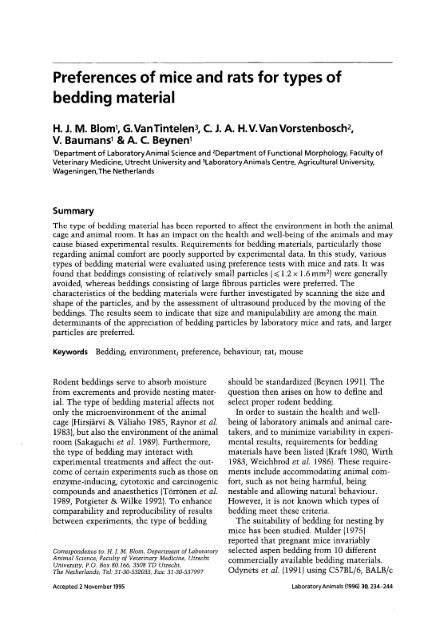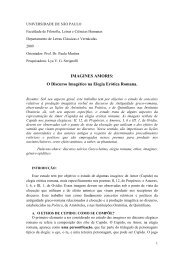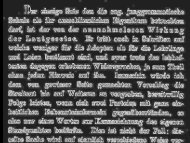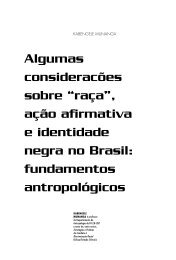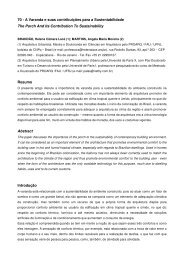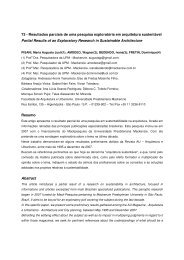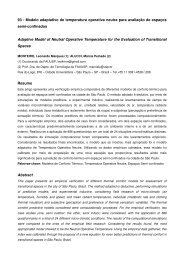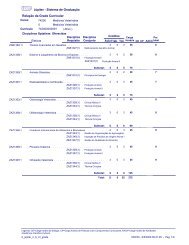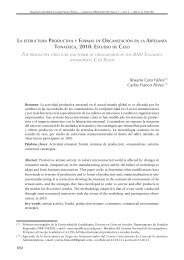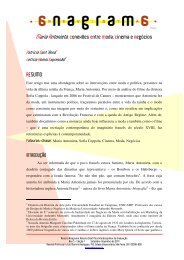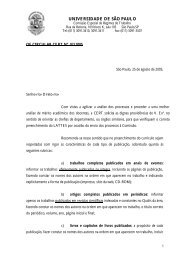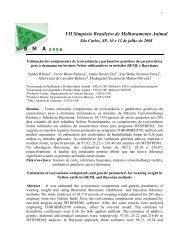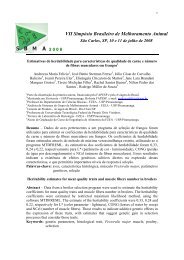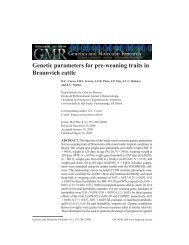Preferences of mice and rats for types of bedding material - USP
Preferences of mice and rats for types of bedding material - USP
Preferences of mice and rats for types of bedding material - USP
You also want an ePaper? Increase the reach of your titles
YUMPU automatically turns print PDFs into web optimized ePapers that Google loves.
<strong>Preferences</strong> <strong>of</strong> <strong>mice</strong> <strong>and</strong> <strong>rats</strong> <strong>for</strong> <strong>types</strong> <strong>of</strong><strong>bedding</strong> <strong>material</strong>H. J. M. Blom1, G. VanTintelen 3 , C. J. A. H. V. Van Vorstenbosch 2 ,V. Baumans' & A. C. Beynen'lDepartment <strong>of</strong> Laboratory Animal Science <strong>and</strong> 2Department <strong>of</strong> Functional Morphology, Faculty <strong>of</strong>Veterinary Medicine, Utrecht University <strong>and</strong> 3Laboratory Animals Centre, Agricultural University,Wageningen, The Netherl<strong>and</strong>sSummaryThe type <strong>of</strong> <strong>bedding</strong> <strong>material</strong> has been reported to affect the environment in both the animalcage <strong>and</strong> animal room. It has an impact on the health <strong>and</strong> well-being <strong>of</strong> the animals <strong>and</strong> maycause biased experimental results. Requirements <strong>for</strong> <strong>bedding</strong> <strong>material</strong>s, particularly thoseregarding animal com<strong>for</strong>t are poorly supported by experimental data. In this study, various<strong>types</strong> <strong>of</strong> <strong>bedding</strong> <strong>material</strong> were evaluated using preference tests with <strong>mice</strong> <strong>and</strong> <strong>rats</strong>. It wasfound that <strong>bedding</strong>s consisting <strong>of</strong> relatively small particles I,::; 1.2 x 1.6mm 2 ) were generallyavoided, whereas <strong>bedding</strong>s consisting <strong>of</strong> large fibrous particles were preferred. Thecharacteristics <strong>of</strong> the <strong>bedding</strong> <strong>material</strong>s were further investigated by scanning the size <strong>and</strong>shape <strong>of</strong> the particles, <strong>and</strong> by the assessment <strong>of</strong> ultrasound produced by the moving <strong>of</strong> the<strong>bedding</strong>s. The results seem to indicate that size <strong>and</strong> manipulability are among the maindeterminants <strong>of</strong> the appreciation <strong>of</strong> <strong>bedding</strong> particles by laboratory <strong>mice</strong> <strong>and</strong> <strong>rats</strong>, <strong>and</strong> largerparticles are preferred.Keywords Bedding; environment; preference; behaviour; rat; mouseRodent <strong>bedding</strong>s serve to absorb moisturefrom excrements <strong>and</strong> provide nesting <strong>material</strong>.The type <strong>of</strong> <strong>bedding</strong> <strong>material</strong> affects notonly the microenvironment <strong>of</strong> the animalcage (Hirsjiirvi &. Viiliaho 1985, Raynor et al.1983), but also the environment <strong>of</strong> the animalroom (Sakaguchi et al. 1989). Furthermore,the type <strong>of</strong> <strong>bedding</strong> may interact withexperimental treatments <strong>and</strong> affect the outcome<strong>of</strong> certain experiments such as those onenzyme-inducing, cytotoxic <strong>and</strong> carcinogeniccompounds <strong>and</strong> anaesthetics (Torronen et al.1989, Potgieter &. Wilke 1992). To enhancecomparability <strong>and</strong> reproducibility <strong>of</strong> resultsbetween experiments, the type <strong>of</strong> <strong>bedding</strong>Correspondence to: H. f. M. Blom, Department <strong>of</strong> LaboratoryAnimal Science, Faculty <strong>of</strong> Veterinary Medicine, UtrechtUniversity, P.O. Box 80.166, 3508 TD Utrecht,The Netherl<strong>and</strong>s; Tel: 31-30-532033, Fax: 31-30-537997Accepted 2 Novem ber 1995should be st<strong>and</strong>ardized (Beynen 1991). Thequestion then arises on how to define <strong>and</strong>select proper rodent <strong>bedding</strong>.In order to sustain the health <strong>and</strong> wellbeing<strong>of</strong> laboratory animals <strong>and</strong> animal caretakers,<strong>and</strong> to minimize variability in experimentalresults, requirements <strong>for</strong> <strong>bedding</strong><strong>material</strong>s have been listed (Kraft 1980, Wirth1983, Weichbrod et al. 1986). These requirementsinclude accommodating animal com<strong>for</strong>t,such as not being harmful, beingnestable <strong>and</strong> allowing natural behaviour.However, it is not known which <strong>types</strong> <strong>of</strong><strong>bedding</strong> meet these criteria.The suitability <strong>of</strong> <strong>bedding</strong> <strong>for</strong> nesting by<strong>mice</strong> has been studied. Mulder (1975)reported that pregnant <strong>mice</strong> invariablyselected aspen <strong>bedding</strong> from 10 differentcommercially available <strong>bedding</strong> <strong>material</strong>s.Odynets et al. (1991) using C57BL/6, BALB/cLaboratoryAnimals (1996) 30, 234-244
Bedding <strong>material</strong>s <strong>and</strong> rodent preferences235<strong>and</strong> wild <strong>mice</strong> also found that <strong>for</strong> nestbuilding aspen <strong>bedding</strong> was the favourite <strong>of</strong>five different <strong>types</strong> <strong>of</strong> <strong>bedding</strong> <strong>material</strong>. Thesestudies indicate that the origin <strong>of</strong> <strong>bedding</strong><strong>material</strong> is an important determinant in theappraisal by the <strong>mice</strong>, but other propertiessuch as particle size or dust content may beimportant as well. When <strong>of</strong>fered a choice <strong>of</strong>various possibilities, rodents may be able toselect the most suitable type <strong>of</strong> <strong>bedding</strong> orcage floor covering. On this assumptionpreference experiments were conducted with<strong>mice</strong> <strong>and</strong> <strong>rats</strong> to investigate their appraisal <strong>of</strong>different <strong>types</strong> <strong>of</strong> cage floor covering. In anattempt to elucidate the basis <strong>for</strong> theobserved choice behaviours <strong>of</strong> the animals,selected properties <strong>of</strong> the <strong>bedding</strong>s used werestudied.Materials <strong>and</strong> methodsPreferencetest systemsThe test systems used <strong>for</strong> <strong>mice</strong> lBlom et a1.1992)<strong>and</strong> <strong>rats</strong> (Blom et a1. 1995)have beenvalidated <strong>and</strong> described in detail. Briefly, weused a multiple-choice housing system consisting<strong>of</strong> a central cage surrounded by eithertwo or four test cages. The wire-toppedcentral cage was made <strong>of</strong> transparent perspex<strong>and</strong> was lacking food <strong>and</strong> water. Macrolontype I (UNO Roestvaststaal, Zevenaar, TheNetherl<strong>and</strong>s) <strong>and</strong> type 375 (RUCO Metaalindustrie,Valkenswaard, The Netherl<strong>and</strong>slwere used as test cages <strong>for</strong> <strong>mice</strong> <strong>and</strong> <strong>rats</strong>,respectively. The test cages were suppliedwith a known amount <strong>of</strong> food pellets (RMH-B®,Hope Farms, Woerden, The Netherl<strong>and</strong>s)in the food hopper <strong>of</strong> the wire top <strong>and</strong> had adrinking bottle with a known amount <strong>of</strong> tapwater. The type <strong>of</strong> floor covering differedbetween the test cages <strong>and</strong> between experiments.The central cage <strong>and</strong> test cages wereconnected by passages.Each choice test started with the introduction<strong>of</strong> a single animal in the central cage <strong>of</strong> atest system with thoroughly cleaned cages<strong>and</strong> passages. During the test period <strong>of</strong> 48 hthe animal could move freely from one cageto another. In the test system <strong>for</strong> <strong>mice</strong>, allpassages between the cages were recordedphoto-electrically. In selected tests, thebehaviour <strong>of</strong> the C57BL/6J1comouse wasrecorded on video. In the rat test system,passages were recorded by means <strong>of</strong> electronicbalances which were placed under thetest cages. Continuous turning <strong>of</strong> the preferencetest system during the testing <strong>of</strong> eachmouse or turning its position between thetesting <strong>of</strong> each rat was per<strong>for</strong>med to cancelout any bias <strong>of</strong> choice behaviour related tothe position <strong>of</strong> the preference test systemwithin the experimental room. At the end <strong>of</strong>each test period, animal preference wasassessed by calculating (relative) dwellingtimes per cage <strong>and</strong> occasionally analysinganimal behaviour per cage.Preference testsFour experiments were conducted with <strong>mice</strong><strong>and</strong> one with <strong>rats</strong>. Table 1 summarizes the<strong>types</strong> <strong>of</strong> floor covering tested. In the firstseries with <strong>mice</strong>, the choice behaviour wasstudied in a test system with four test cages.The floor <strong>of</strong> the test cages was covered eitherwith the wire mesh, aspen wood chips,shredded filter paper or Hahnflock® H9sawdust (Fig. I, panel A). The perspex floor <strong>of</strong>the central cage had no covering throughout.In the experiments with <strong>rats</strong> there werefour test cages with different <strong>types</strong> <strong>of</strong> <strong>bedding</strong>:Hahnflock® H9, Lignocel® 58/15, Lignocel@3/4 or Hahnflock® Tierwohl. All these <strong>bedding</strong>swere manufactured <strong>of</strong> fir/spruce, butdiffered in particle size (Fig. I, panel B).Thefloor <strong>of</strong> the central cage was covered with awire mesh (stainless steel wire: rod diameter,3.3 mm; mesh size, 40 x 40 mm 2 ).In three more experiments with <strong>mice</strong>, atest system with two test cages was used. Thetest cages were fitted with wire mesh versuswood chips; wire mesh versus Hahnflock®H9 sawdust; <strong>and</strong> wood chips versus Hahnflock®H9 sawdust. The floor <strong>of</strong> the centralcage was again left without covering.Animals <strong>and</strong> husb<strong>and</strong>ryFor the first experiment with <strong>mice</strong>, 20 femaleC57BL/6JIco<strong>and</strong> 20 female BALB/cBYJlcoanimals, aged 6 to 24 weeks, were used. Nineto 16<strong>of</strong> these <strong>mice</strong> <strong>of</strong> each strain were used inthe three experiments conducted later. Be<strong>for</strong>e<strong>and</strong> between the experiments, the <strong>mice</strong> were
236 Blometal.Table 1 Types <strong>of</strong> floor covering <strong>material</strong> used in the test cages during the preference tests with <strong>mice</strong> <strong>and</strong><strong>rats</strong>. (Fig. 1 shows the <strong>material</strong>s listed)FloorcoveringType <strong>of</strong><strong>material</strong> Trade name particles Size SupplierWire mesh not applicable not applicable rod diameter, 2 mm UNO Roestvaststaal,mesh size, 10 x 10mm 2 Zevenaar, The Netherl<strong>and</strong>sWood chips Finn Tapvei aspen chips 4x4x 1mm 3 Tapvei OY, Kaavi, Finl<strong>and</strong>Filter paper Whatmann shreds approx. 2 x 5 mm 2 Boom, Meppel, ThechromatographicNetherl<strong>and</strong>s (shreds werepaper typeproduced by cutting sheets3MM Chr.<strong>of</strong> paper)Sawdust Hahnflock® H9 granulate 0.9 x 1.3mm 2 Hahn & Co, Bredenbek-Kronsburg, GermanySawdust Lignocel® 58/15 granulate 1.0 x 2.5 mm 2 Rettenmaier & 56hne,Ellwangen-Holzmuhle,GermanyWood Lignocel® 3/4 fibres 2.0 x7.0mm 2 Rettenmaier & 56hne,shavingsEllwangen-Holzmuhle,GermanyWood Hahnflock® fibres 2.0 x4.5mm 2 Hahn & Co, BredenbekshavingsTierwohl Kronsburg, Germanyhoused in groups <strong>of</strong> five animals in a housingsystem consisting <strong>of</strong> two wire-toppedMacrolon type I cages connected by a passage.This housing system allowed the animals tobecome accustomed to moving through thepassages <strong>of</strong> the test system. Both cages <strong>of</strong>each system were supplied with food pellets,water <strong>and</strong> sawdust <strong>bedding</strong> ILignocel® S8/15).Stock <strong>and</strong> experimental rooms (conventional)had a controlled photoperiod (stock <strong>and</strong>experimental room: white light, approx.200 Ix at 1m above the floor from 07:00-19:00h, dark in stock room, <strong>and</strong> 700nm, redlight, approx. 5lx at 1m above the floor in theexperimental room from 19:00-07:00 h),temperature (20-22°C), relative humidity(50-60%) <strong>and</strong> ventilation (15 air changes perhour).In the experiment with <strong>rats</strong>, 12 female <strong>and</strong>12 male Wistar (Cpb:WU) animals, bred at theLaboratory Animals Centre, Wageningen,were used. The <strong>rats</strong> were tested at the age<strong>of</strong> 12 to 31 weeks; each rat was tested once.The animals had been born <strong>and</strong> housed inMacrolon type 375 cages with sawdust<strong>bedding</strong> (Lignocel® S8/15). until weaning.From weaning to the beginning <strong>of</strong> theexperiment, the animals were housed in,.. ",.. ..• 1," .J' t• . i:' ~•• \.' ,1'0;".:..... :, "~'l".~. 1./ "".'> :' . ~ . _. " . ..'.~'.;.,.,~. q1 _~ ".• ...... : ..•..•... ',' . :.'P..... . ~' --' .;:::•": ~ t" , _ABFig 1 Types <strong>of</strong> cage floor covering used in the preference tests with <strong>mice</strong> (panel A (from left to right):wire mesh, FinnTapvei 4 x 1 xl aspen wood chips, shredded filter paper, Hahnflock® H9 sawdust) <strong>and</strong> <strong>rats</strong>(panel B (from left to right): Hahnflock® H9, Lignocel® 58/15,Lignocel® 3/4, Hahnflock®Tierwohl). Table 1documents further characteristics <strong>of</strong> the floor coverings
Bedding <strong>material</strong>s <strong>and</strong> rodent preferences237groups <strong>of</strong> three in metal cages (type KS/4,RUeO Metaalindustrie) with wire meshfloors (stainless steel wire: rod diameter,2mm; mesh size, 10 x 50mm 2 ) <strong>and</strong> sawdust<strong>bedding</strong> (Lignocel® S8/15) at 70mm underneath.The <strong>rats</strong> had free access to foodpellets (RMH-B®) <strong>and</strong> tap water. Immediatelybe<strong>for</strong>e testing, each rat went through apre-test (habituation) period <strong>of</strong> 48 h in thetest system with uni<strong>for</strong>m cages. Each testcage was fitted with a wire mesh floor(stainless steel wire: rod diameter, 2 mm;mesh size, 10 x 30 mm 2 ) with sawdust <strong>bedding</strong>(Lignocel® 58/15) at 25 mm underneath.The animals were kept <strong>and</strong> tested inconventional rooms with controlled photoperiod(06:00-18:00h: light, approx. 470lx at1m above the floor), temperature (20-22°C),relative humidity [50-70%) <strong>and</strong> ventilation(18 air changes per hour).Characterization <strong>of</strong> <strong>bedding</strong> <strong>material</strong>sThe <strong>bedding</strong> <strong>material</strong>s were further characterizedin an attempt to explain the observedchoice behaviours. Actual particle size <strong>and</strong>shape, as well as dust content, was assessedwith the use <strong>of</strong> a scanning electron microscope(Stereoscan, Cambridge Inc,Cambridge, United Kingdom). The <strong>bedding</strong><strong>material</strong>s were also studied <strong>for</strong> ultrasoundproduction when moved. For this purpose,50 ml <strong>of</strong> <strong>bedding</strong> <strong>material</strong> was put in a250 ml glass beaker <strong>and</strong> stirred with a glassrod (approx. 60 rotations min -1). Ultrasoundproduction was detected at 25 cm above the<strong>bedding</strong> <strong>material</strong> with a sensitive condensermicrophone (Type 4135, Briiel &. Kjaer,Nieuwegein, The Netherl<strong>and</strong>s), preamplifier(Type 2633, Briiel &. Kjaer),measuring amplifier (Type 2610, Briiel &.Kjaer), <strong>and</strong> programmable dual filter (TypePDF3700 B, Difa Benelux BV, Breda, TheNetherl<strong>and</strong>s).StatisticalproceduresFor statistical analyses, dwelling times (sec)per cage <strong>for</strong> the 48-h pre-test or test periodwere trans<strong>for</strong>med into their logarithms. APearson correlation matrix <strong>for</strong> dwelling times<strong>of</strong> different cages was constructed to obtainin<strong>for</strong>mation on competition between cages.Differences between mouse strains or sex <strong>of</strong>the <strong>rats</strong> were evaluated using univariaterepeated measures analysis. Differencesbetween floor covering <strong>and</strong> interactions <strong>of</strong>floor covering <strong>and</strong> either mouse strains or sex<strong>of</strong> <strong>rats</strong> or rat preferences during the pre-testperiod was evaluated using multivariaterepeated measures analysis (Wilks' Lambdatest). The level <strong>of</strong> significance was pre-set atP
238 810m eta/.80~
Bedding <strong>material</strong>s <strong>and</strong> rodent preferences 239Table 2 Relative deposition <strong>of</strong> faeces <strong>and</strong> urine <strong>and</strong> relative consumption <strong>of</strong> food <strong>and</strong> water by femaleC57BL/6J1co<strong>and</strong> BALB/cBYJlco <strong>mice</strong> on four different <strong>types</strong> <strong>of</strong> floor covering in a preference testC57BL/6JlcoType <strong>of</strong> floor coveringshredded filter sawdustwire mesh wood chips paper (Hahnflock® H9)Faeces 19.6± 1.9 27.6± 1.9 16.1 ±2.1 35.0±2.1(% <strong>of</strong> tota I bol i)Urine 1.6±0.1 1.7±0.1 1.1 ±0.1 2.0±0.0(mean urine score*)Food 22.2±2.4 23.0± 1.9 26.6±3.0 28.2±2.8(% <strong>of</strong> tota Ig consumed)Water 23.1 ±2.0 23.8± 1.2 27.6± 1.4 25.6±1.4(% <strong>of</strong>total ml consumed)BALB/cBYJlcoType <strong>of</strong> floor coveringshreddedsawdustwire mesh wood chips filter paper (Hahnflock® H9)Faeces 28.6±2.2 27.8±2.3 10.3±0.9 31.3±1.8(% <strong>of</strong>total boli)Urine 1.7±0.1 1.9 ± 0.1 1.1 ±0.1 2.0±0.0(mean urine score*)Food 26.8±2.8 21.6±1.9 22.1 ±2.4 29.5±2.5(% <strong>of</strong> total g consumed)Water 22.2 ± 1.7 26.0±3.0 25.7±1.9 26.1 ±2.0(%<strong>of</strong>total ml consumed)Results are expressed as means ±SEM <strong>for</strong> 20 <strong>mice</strong> per strain*Urine was scored as: 1dry; 2 moist; 3 wet; 4 soakingTo assess ultrasound production <strong>of</strong> the<strong>bedding</strong> <strong>material</strong>s when moved by theanimals, the frequency <strong>and</strong> relative intensity<strong>of</strong> ultra sounds produced after stirring with aglass rod were measured. Ultrasound productionwas strongest with Hahnflock® Tierwahlwood shavings, whereas Hahnflock® H9sawdust produced the fewest ultrasounds(data not shownl. In general, ultrasoundintensity increased with increasing particlesize <strong>of</strong> the <strong>bedding</strong>s tested. The highest levels<strong>of</strong> the ultrasounds were found in the lowerfrequency ranges (20-40 kHz).DiscussionFigure 2 illustrates that shredded filter paperwas so attractive to female laboratory <strong>mice</strong>that it masked differential preferences <strong>for</strong>wood chips, Hahnflock® H9 sawdust <strong>and</strong> awire mesh floor. In the test system with twotest cages, wood chips were preferred oversawdust <strong>and</strong> wire mesh. The preferencepatterns <strong>of</strong> the two inbred strains used weregenerally similar. Apart from relative dwellingtimes, the <strong>mice</strong> also discriminatedbetween the <strong>types</strong> <strong>of</strong> floor covering withrespect to defaecation <strong>and</strong> urination. The<strong>mice</strong> tended to deposit less faeces <strong>and</strong> urinein the cage with shredded filter paper, i.e. thecage where they spent most time on resting.This suggests that to a certain extent <strong>mice</strong>actively keep their nesting area clean fromexcreta. Under practical conditions, multiplecage compartments usually cannot be <strong>of</strong>fered.When shredded paper is given as the sale<strong>bedding</strong> <strong>material</strong> it may become wet quickly.Since the absorbing potency <strong>of</strong> sawdust <strong>bedding</strong>exceeds that <strong>of</strong> shredded filter paper, a
240 Blom etal.60Q)E 4001CQ)~uQ) 20.:::iii~oH9D females88/15 3/4 Tierwohltype <strong>of</strong> <strong>bedding</strong><strong>material</strong>Fig4 Distribution <strong>of</strong> relative dwelling times(means± SEM; n=12 per sex) during the test period<strong>of</strong> 48 h <strong>for</strong> male <strong>and</strong> female Cpb:WU <strong>rats</strong> in a preferencetest system with the central cage <strong>and</strong> fourtest cages fitted with different <strong>types</strong> <strong>of</strong> <strong>bedding</strong><strong>material</strong>. Repeated measures analysis: P'ex=0.004;P<strong>bedding</strong>=0.01O;P<strong>bedding</strong> x 'ex=0.173. Dwell ing times <strong>for</strong>Hahnflock® H9 sawdust differed significantly(P=0.0015 to 0.0025, paired t-test) from those <strong>for</strong> theother three test cagescombination <strong>of</strong> both <strong>bedding</strong> <strong>material</strong>s maybe favourable when animals are housed in asingle cage.In the preference tests with <strong>rats</strong>, data onfaeces <strong>and</strong> urine production were not collected.It was however apparent that at theend <strong>of</strong> the test periods more faecal boli werepresent in the central cage with a wire meshfloor than in the test cages with various <strong>types</strong><strong>of</strong> <strong>bedding</strong>. Possibly, <strong>rats</strong> also prefer a cleanliving area.Both <strong>mice</strong> <strong>and</strong> <strong>rats</strong> appeared to avoid<strong>bedding</strong> <strong>material</strong> with relatively small particles(Hahnflock® H9 sawdust I <strong>and</strong> preferred<strong>bedding</strong>s consisting <strong>of</strong> large particles (aspenwood chipsj or fibres (Lignocel® 3/4 woodshavings, Hahnflock® Tierwohl wood shavings,shredded filter paper). Bedding <strong>material</strong>sconsisting <strong>of</strong> relatively small particles areunsuitable <strong>for</strong> nest building (Hamalainel1 &Tirkkonen 1991). The observed preferences<strong>for</strong> <strong>bedding</strong> <strong>material</strong>s may relate to theirsuitability as nesting <strong>material</strong>. Analysis <strong>of</strong>mouse behaviour revealed that digging, i.e.manipulation <strong>of</strong> <strong>bedding</strong>, <strong>and</strong> resting in a nestwere per<strong>for</strong>med most on the preferred <strong>bedding</strong>.The preference <strong>of</strong> the <strong>mice</strong> <strong>for</strong> shreddedfilter paper is in accordance with the results_maleswire mesh(cenlral cage)<strong>of</strong> Nolen <strong>and</strong> Alex<strong>and</strong>er (1966). In a limitednumber <strong>of</strong> additional choice tests with fourtest cages we <strong>of</strong>fered <strong>mice</strong> a cage with a sheet<strong>of</strong> filter paper fixed to the floor instead <strong>of</strong>shredded filter paper. The filter paper wasnow only preferred when the animals managedto remove <strong>and</strong> tear the sheet (Fig. n Ifthey did not succeed in doing so, the cagewith filter paper floor covering was avoided.Apparently, the structure <strong>of</strong> filter paper thathas been shredded may determine preference<strong>of</strong> the <strong>mice</strong>.Small <strong>bedding</strong> particles <strong>and</strong> especially dust(particles smaller than 300/lm, Wirth 1983)can be irritating or damaging when inhaled(Sakaguchi et al. 1989, Thigpen et al. 1989).Such particles also irritate the vaginalmucosa (Plank & Irwin 1966) or causepreputial infections IVan Herck,' personalcommunication). In this light it is plausiblethat Hahnflock® H9 sawdust is avoided whencompared with the other <strong>bedding</strong> <strong>material</strong>stested. Nevertheless, the female <strong>rats</strong> tendedto prefer Hahnflock® Tierwohl wood shavingsas <strong>bedding</strong> <strong>material</strong>, despite its highproportion <strong>of</strong> dust. .Rodents are very sensitive to ultrasoundlRalls 1967, Sales & Milligan 1992). Weassumed that moving <strong>of</strong> <strong>bedding</strong> <strong>material</strong>sby rodents may produce ultrasonic soundsthat can either be irritating or pleasurable.The <strong>bedding</strong> <strong>material</strong>s tested were found toproduce ultrasounds upon stirring, thehighest intensity being caused by Hahnflock®Tierwohl wood shavings. This characteristic<strong>of</strong> Hahnflock® Tierwohl couldhave contributed to the relatively highdegree <strong>of</strong> appraisal by the female <strong>rats</strong>. Thesame may be true <strong>for</strong> the preferencetowards aspen wood chips (Finn Tapvei)when compared with Hahnflock® H9 sawdust,as displayed by the <strong>mice</strong>. Thus,relative preference <strong>and</strong>/or avoidance <strong>of</strong> agiven <strong>bedding</strong> <strong>material</strong> may be associatedwith ultrasound production.The results <strong>of</strong> this study indicate that size<strong>and</strong>/or shape might be a major determinant inthe appreciation <strong>of</strong> <strong>bedding</strong> particles bylaboratory <strong>mice</strong> <strong>and</strong> <strong>rats</strong>. Beddings consisting<strong>of</strong> large fibres seem to be preferred. It shouldhowever be emphasized that the present datacannot be interpreted unequivocally to show
Bedding <strong>material</strong>s <strong>and</strong> rodent preferences 24180 80AB~ ~:>R 60* 600(])
242 Blom eta',Fig 6 Scanning electron micrographs <strong>of</strong> <strong>bedding</strong> <strong>material</strong>s studied in preference tests with <strong>mice</strong> <strong>and</strong> <strong>rats</strong>.The photographs have approximately identical magnification: the bar indicates 1mm
Bedding <strong>material</strong>s <strong>and</strong> rodent preferences243Fig 7 Illustration <strong>of</strong> a test cage with a sheet <strong>of</strong>filter paper fixed to the floor as used in a preferencetest system <strong>for</strong> <strong>mice</strong> consisting <strong>of</strong> the centralcage <strong>and</strong> four test cages with different <strong>types</strong> <strong>of</strong>cage flooring (d.Table 1).Thetest cage with the filterpaper was either avoided (left) or preferred (right)depending on the animal being successful in creatinga nest by tearing the sheet <strong>of</strong> papermay contribute to the adequate adaptation <strong>of</strong>existing guidelines <strong>and</strong> practices on housinglaboratory animals. Promoting the adaptation<strong>of</strong> laboratory animal housing systemstowards the animals' needs may be conduciveto animal welfare but does not necessarilysustain scientific interests. The use <strong>of</strong> preferred<strong>bedding</strong> <strong>material</strong> so as to improve theanimals' well-being seems appropriate, but itshould be realized that certain experimentsrequire specific cage floor coverings, such aswire mesh bottoms, that are not compatiblewith the animals' preference. Thus, theintroduction <strong>of</strong> changes should always beconsidered along with their consequences <strong>for</strong>the experiment.Acknowledgments The authors are grateful to BMI,Helmond, distributor <strong>of</strong> Lignocel® <strong>and</strong> Hahnflock®<strong>bedding</strong>s in The Netherl<strong>and</strong>s <strong>and</strong> to Tapvei OY, Kaavi,Finl<strong>and</strong>, <strong>for</strong> kindly supplying <strong>bedding</strong> <strong>material</strong>s, <strong>and</strong> toDr J. Van den Broek <strong>for</strong> assisting with the statisticalanalysis.ReferencesBeynen AC (1991) The basis <strong>for</strong> st<strong>and</strong>ardization <strong>of</strong>animal experimentation. Sc<strong>and</strong>inavian Journal <strong>of</strong>Laboratory Animal Science 18, 95-9Blom HJM Van Vorstenbosch CJAHV, Baumans V,Hoogervorst MJC, Beynen AC, Van Zuthpen LFM(1992) Description <strong>and</strong> validation <strong>of</strong> a preferencetest system to evaluate housing conditions <strong>for</strong>laboratory <strong>mice</strong>. Applied Animal Behaviour Science35,67-82Blom HJM, Van Tintelen G, Baumans V, Van denBroek J, Beynen AC (1995) Development <strong>and</strong>application <strong>of</strong> a preference test system to evaluatehousing conditions <strong>for</strong> laboratory <strong>rats</strong>. AppliedAnimal Behaviour Science 43, 279-90Hiimiiliiinen A, Tirkkonen T (19911 How to choose agood <strong>bedding</strong> <strong>material</strong>. Laboratornye Zhyvotnye 1,62-5Hirsjiirvi P, Viiliaho T (1985) Microclimate in two<strong>types</strong> <strong>of</strong> rat cages. Zeitschrift flir Versuchstierkunde27, 93Mulder JB (1975) Bedding preferences <strong>of</strong> pregnantlaboratory-reared <strong>mice</strong>. Behavior Research Methods& Instrumentation 7, 21-2Kraft LM (1980) The manufacture, shipping <strong>and</strong>receiving <strong>and</strong> quality control <strong>of</strong> rodent <strong>bedding</strong><strong>material</strong>s. Laboratory Animal Science 30,366-74Les EP (1980) Comment to Kraft. Laboratory AnimalScience 30, 75Nolen GA, Alex<strong>and</strong>er JC (1966) Effects <strong>of</strong> diet <strong>and</strong> type<strong>of</strong> nesting <strong>material</strong> on the reproduction <strong>and</strong>lactation <strong>of</strong> the rat. Laboratory Animal Care 16,327-36Odynets A, Simonova 0, Kozhuhov A, et al. (1991)Beddings <strong>for</strong> laboratory animals: criteria <strong>of</strong>biological evaluation. Laboratornye Zhyvotnye 1,70-6Plank S1, Irwin R (19661 Infertility <strong>of</strong> guinea pigson sawdust <strong>bedding</strong>. Laboratory Animal Care16, 9-11Potgieter FJ, Wilke PI (1992) Laboratory animal <strong>bedding</strong>:a review <strong>of</strong> wood <strong>and</strong> wood constituents as apossible source <strong>of</strong> external variables that couldinfluence experimental results. Animal Technology43,65-88Ralls K (196 7lAuditory sensitivity in <strong>mice</strong>: Peromyscus<strong>and</strong> Mus musculus. Animal Behaviour 15, 123-8Raynor TH, Steinhagen WH, Hamm Jr TE (19831Differences in the microenvironment <strong>of</strong> a polycarbonatecaging system; <strong>bedding</strong> vs raised wirefloors. Laboratory Animals 17, 85-9Sales GD, Milligan SR (1992) Ultrasound <strong>and</strong>laboratory animals. Animal Technology 43,89-98Sakaguchi M, Inouye 5, Miyazawa H, Kamimura H,Kimura M, Yamazaki 5 (19891 Evaluation <strong>of</strong> dustrespirators <strong>for</strong> elimination <strong>of</strong> mouse aeroallergens.Laboratory Animal Science 39, 63-6Thigpen JE, Lebetkin EH, Dawes ML, et al. 11989) Ast<strong>and</strong>ard procedure <strong>for</strong> measuring rodent <strong>bedding</strong>particle size <strong>and</strong> dust content. Laboratory AnimalScience, 39, 60-2
244810m etal.T6rr6nen R, Pelkonen K, Kiirenlampi S 11989) Enzyme-inducing<strong>and</strong> cytotoxic effects <strong>of</strong> wood-based<strong>material</strong>s used as <strong>bedding</strong> <strong>for</strong> laboratory animals;comparison by a cell culture study. Life Sciences 45,559-65Weichbord RH, Hall JE, Simmonds RC, Cisar CF119861Selecting <strong>bedding</strong> <strong>material</strong>. LaboratoryAnimals 15, 25-9Wirth H \19831 Criteria <strong>for</strong> the evaluation <strong>of</strong> laboratoryanimal <strong>bedding</strong>. Laboratory Animals 17, 81-4


